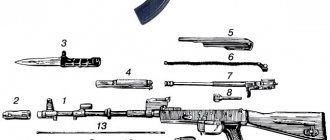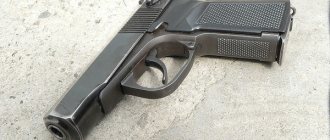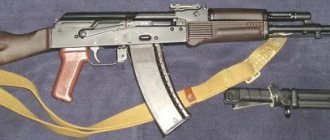What it is?
When firing from different types of automatic and semi-automatic weapons (both pistols and machine guns, shotguns), the bolt moves back with each shot. In this case, the spent cartridge case is ejected, the hammer is cocked (not to be confused with the trigger), and a new cartridge is sent into the barrel. This happens as long as there are cartridges in the store.
As soon as the last one is fired, the bolt does not return to its original position, but seems to be stuck in place. This is the shutter stop.
It is carried out differently on different types of weapons, and sometimes not at all. Among pistols one can cite the Makarov pistol, TT, HK4, Mauser M1910, Beretta M1934, among submachine guns – the Slovak “Scorpion”, and among machine guns – M16 and subsequent modifications, as well as AK-12.
In some modern weapons, the bolt stop is even modified with a special mechanism that ejects the magazine after the last cartridge has been chambered. This is not very convenient (when moving intensively during combat, it is not always possible to find a lost magazine), but it saves an extra second - you do not need to first disconnect an empty magazine in order to insert a full one. But this occurs in relatively few types of weapons.
What is the length of a 9 mm Makarov pistol?
The 9-mm Makarov pistol (PM, GRAU Index - 56-A-125) is a Soviet self-loading pistol developed by Soviet designer Nikolai Fedorovich Makarov in 1948. … The Makarov pistol
| Makarov pistol (PM) | |
| Characteristics | |
| Weight, kg | 0.73 (without ammo) 0.81 (loaded) |
| Length, mm | 161,5 |
| Barrel length, mm | 93,5 |
What is it for?
What is the purpose of the shutter stop? Usually, in order to send a cartridge into the magazine, you need to jerk the bolt. It would seem that there is no problem, because it takes a trained person a split second. However, as practice shows, in battle this can become a real obstacle. On the one hand, a person may simply be confused and not understand why a machine gun, into which a full magazine is inserted, refuses to fire. On the other hand, on some types of weapons it is quite difficult to move the bolt, for example, while wearing gloves. A striking example is the well-known M4. During combat “shaking” it can be quite difficult to jerk the shutter.
It is to solve this problem that the shutter stop is used. To send a new cartridge into the barrel, you do not need to distort the bolt. Some weapons are automatically released from the delay as soon as a new magazine is inserted into them - the most convenient, but at the same time difficult option. In other types, you need to press a specially provided button that removes the weapon from the bolt stop.
That is, the fighter saves a fraction of a second to move the shutter. In modern fleeting battles, which take place not in forests or fields, but in cities or even indoors, such time savings may well save a person’s life.
An additional function is to alert the shooter that they are out of ammo and need to insert a new magazine, rather than continuing to pull the trigger hoping to fire a few more shots.
What is the fuse for?
A fuse is an electrical switching device designed to disconnect the protected circuit by opening or destroying live parts specially designed for this purpose under the influence of a current exceeding a certain value.
Interesting materials:
What is the root of the word peep? What is the root of the word zabati? What is the root of the word statement? What is the root of the word bunny? What is the root of the word again? What is the root of the word note? What is the root of the word grain? What is the root of the word millstone? What is the root of the word anger? What is the root of the word snake?
Advantages and disadvantages
What advantage the bolt lag of the PM, TT, AK-12 and other weapons provides is already clear from what was described above.
Unfortunately, there is also a drawback. It consists of the accidental entry of foreign objects (debris, dirt, dust) into an open mechanism - not protected, as usual, by a shutter.
The fact is that at the moment when the magazine is empty and the fighter loses the opportunity to conduct further fire, the best thing he can do is move to cover, fall, or at least crouch, making it difficult for the enemy to fire. It is at such moments that it is very difficult to ensure that the weapon is protected from dirt and debris. And this may well lead to it simply jamming. Moreover, it can only be put in order by partial or even complete disassembly - in battle there simply will not be time for this.
However, this happens relatively rarely, so the advantages of the slide stop (saving time when reloading and notifying the shooter that the magazine is empty) outweigh the only drawback.
AK vs AR. Part II
Logically, it would be worth starting with a discussion of the advantages and disadvantages of the Soviet 5.45x39 and American 5.56x45 cartridges, but this is a separate topic, so I will limit myself to stating a fact.
The domestic one is weaker in power when leaving the barrel, but this is not its disadvantage. On the contrary, less power means less weapon recoil, higher accuracy when firing in bursts, while in terms of penetration, our cartridge still remains unattainable for either American or European designers. Store aspect
Unlike the M16 rifle itself, which is full of small details, its magazine is surprising in its simplicity of shape to the point that in a hurry it can be inserted into the weapon upside down (see the thesis about foolproofing in the first part).
The absence of linings that reinforce the bends of the M16 magazine is striking, although they are present in the AK and Sturmgewehr magazines. An unreinforced bend is more sensitive to mechanical stress, which means that due to its deformation the stability of the cartridge feed line into the chamber will not be ensured.
The casket simply opens. These magazines were to be disposable and supplied in plastic packaging. The fighter had to tear off this packaging (with his teeth?) and after shooting the magazine (in whole or in part) throw it away. The principle, which works great for disposable tableware, did not suit the American customer. The stores did not become disposable, but nothing happened in terms of design changes. Of course, this did not take long to affect reliability.
The walls of the M16 magazine are reinforced with two vertical stamped stiffening ribs, which, in addition, serve to reduce friction between cartridges and the walls of the magazine. But the rigidity they must provide is not at all sufficient for reliable operation.
Here is a diagram of the distribution of forces inside a regular store:
The force of the feed spring passes through one vertical row of cartridges. On the one hand, it must be sufficient to lift its entire mass. On the other hand, a spring that is too powerful will make it difficult to load, and the upper cartridge will be pressed so tightly against the bend that the bolt's rolling energy may not be enough to reliably feed it from the magazine into the chamber.
Let's add entropy - let's step on the store with our foot. Its walls will come closer together, and gaps will appear between the cartridges of one vertical row:
The force of the feed spring will be applied to the upper cartridge through one tangentially, and a force will appear pressing on the walls of the magazine. Depending on the degree and quality of contamination (let's add entropy), a component will appear between the cartridge and the magazine body due to friction, directed against the spring feed force.
In order for the cartridges to diverge, it is enough to move the side walls or stick debris on them by about 1 mm. That is, a minor change in the system will produce an abrupt result.
Where it leads? Even if the cartridges do not jam, and for this you need to try very hard to fill the magazine with dirt or cover it with dust, the supply of the cartridge to the chambering line will slow down. As a result, the bolt simply does not have time to capture the next cartridge when it rolls up, because it has not yet risen to the feed level.
Plastic magazines have better elasticity, so they will simply regain their shape or break if pressed hard enough. But when a lot of dirt gets inside, the same effect will happen. Such a disaster is equally likely for the magazines of both machines. But let's look at their design inside. In the M16, the bolt slides over the top magazine cartridge during recoil. In an AK, when the bolt is rolled back, the rammer presses on it, pushing the entire row down:
At the same time, dirt and debris are shaken off, reducing the likelihood of its critical accumulation at one point, which increases the reliability of the store by an order of magnitude.
Fastening the store
So you say “ergonomics”, “ergonomics”. Let's attach the magazine to the Kalashnikov assault rifle. To do this you need to make two movements. Catch the front edge of the receiving window with the magazine hook and turn it until the latch engages.
The actuation of the latch will not only be audible, but also tactile. "Chock!" - as Mikhail Timofeevich said. This is ensured by a fairly strong latch spring and its large working stroke. The magazine itself works like a lever, so it doesn’t require much force to operate. This movement is the same for any situation when working with the machine and for users of any level. An athlete, a special forces soldier, a simple infantryman, or a child with a toy will do this movement in exactly the same way.
Now we will attach the magazine to the Stoner machine gun. Unlike AK, it won’t work in two movements. And one more thing. Although, at first glance, this is exactly how it should happen. To do this, you need to get the magazine into the shaft window without looking, that is, accurately align the outer perimeter of the magazine and the internal receiving window. Such precision is achieved through persistent training in situations that are far from stressful. In life you have to reload a weapon while sitting, lying down and sideways, but here skills don’t help much. Therefore, the entrance to the mine is made not at a right angle, but with a slight bevel. This increases the size of the receiving window, making it easier for the magazine to hit it with the corner, but adds one more movement - turning it to the perpendicular so that the magazine begins its movement in the shaft.
Thus, the first action is equivalent to manipulating a Kalashnikov assault rifle. Okay, we caught the window, turned on the magazine, and pushed it into the shaft. All? No, “everything” is just beginning. The magazine latch is extremely snotty in terms of operation length - only two millimeters.
It fires into a stamped hole in the wall of the store, through which entropy and dirt seeps in.
If this dirt did not fall inside the magazine, but, say, dried up or appeared in the form of a sliver or pebble, then the latch will not secure anything. There is no lever to push it inside the store! Whether the shooter will feel the latch engage is a question. But he also has gloves on his hands so that he doesn’t rub his palms on the Picatinny rails. On the other hand, the latch spring was too strong. Then, for the latch to work, another force must act against the movement of the magazine in the shaft. It is only the weight of the machine itself. If it is not enough, the problem can be solved only by accelerating the store. So the process of attaching it is crowned by a characteristic slap with the palm from below, knocking down the weapon that had already left the line of sight. Hello Schmeisser.
Oddly enough, the location of the release button on one side of the weapon does not cause any inconvenience. Although it increases the likelihood of the magazine accidentally unfastening.
Shutter lag
We've secured the store, what's next? That's right - the shutter stop. To do this, you need to hit its button with your thumb or index finger, depending on which hand you are fastening the magazine with. In reality, this is often done differently. All it takes is once in a stressful situation for this latch to fail to work or not to get your finger into it, and for the rest of your life you will turn it off with a clap of the palm of your left hand, knocking the weapon off the aiming line, which was already gone after the clap on the magazine from below.
With all these manipulations, let’s not forget that the center of gravity of the weapon is in front of the right hand, forcing it to strain further, and control of the position of the weapon on the aiming line during the process of changing the magazine remains possible only in the refined conditions of exemplary performances.
As you know, there are no delays in AK. Therefore, the problem of releasing the shutter from the delay by pressing a button or clapping your palm on it does not exist; instead, the usual jerking of the shutter occurs. In terms of energy, such a movement is more costly than clapping your palm, this is indisputable. But if you do it with your right hand, holding the weapon with your left hand by the fore-end, you can easily control its position on the aiming line. The center of gravity will be between two points of support - the fore-end and the heel of the butt, and will not further strain the hand holding the machine gun in weight. If you fasten the magazine in the Orthodox way, with your right hand, then your hand will be next to the cocking handle. With a further movement after cocking the bolt, the hand will be where it needs to be - at the handle of the weapon. Thus, the M16's bolt lag does not provide any decisive advantage over its absence on the AK.
Separately, it is worth mentioning the manner of reloading an AK with the left hand. Anyway, this topic will come up in discussions of the article. I'm not against it, I'm rather for it.
You need to be able to reload not only with any hand, but also with your foot, and first of all with your head. I am against this manner being imposed as mandatory in the training system, which we now often see. Establishing an unnatural mannerism as a skill can be costly in practice.
The article uses a photograph from the article: Andrey Fishchev, The Basic Commandment, Kalashnikov magazine No. 7, 2006. Regarding other photographs, the author is not aware of the restrictions on their use.
To be continued…











